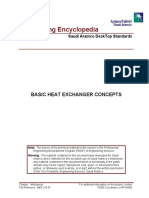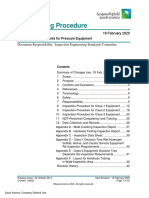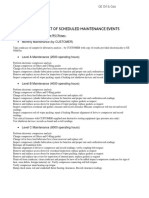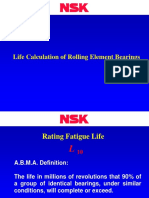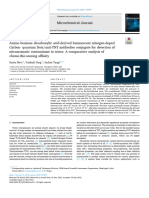Fire Heater Test and Inspection
Fire Heater Test and Inspection
Uploaded by
Mamdouh ElhanafyCopyright:
Available Formats
Fire Heater Test and Inspection
Fire Heater Test and Inspection
Uploaded by
Mamdouh ElhanafyOriginal Description:
Copyright
Available Formats
Share this document
Did you find this document useful?
Is this content inappropriate?
Copyright:
Available Formats
Fire Heater Test and Inspection
Fire Heater Test and Inspection
Uploaded by
Mamdouh ElhanafyCopyright:
Available Formats
Engineering Encyclopedia
Saudi Aramco DeskTop Standards
PROCESS HEATER TEST and INSPECTION
Note: The source of the technical material in this volume is the Professional
Engineering Development Program (PEDP) of Engineering Services.
Warning: The material contained in this document was developed for Saudi
Aramco and is intended for the exclusive use of Saudi Aramco’s employees.
Any material contained in this document which is not already in the public
domain may not be copied, reproduced, sold, given, or disclosed to third
parties, or otherwise used in whole, or in part, without the written permission
of the Vice President, Engineering Services, Saudi Aramco.
Chapter : Mechanical For additional information on this subject, contact
File Reference: MEX-105.05 PEDD Coordinator on 874-6556
Engineering Encyclopedia Inroduction to Process Heaters
Process Heater Test and Inspection
Section Page
INFORMATION ............................................................................................................... 2
CONSIDERATIONS AND RECOMMENDATIONS FOR PROCESS HEATER
TEST AND INSPECTION ...................................................................... 2
Preparation for Inspection .................................................................................... 2
External Heater Inspection ................................................................................... 3
Ladders, Stairways, and Platforms ............................................................ 3
Air Ducts and Flue Gas Ducts.................................................................... 4
Support Structure and Heater Casing ........................................................ 4
Stack.......................................................................................................... 4
Heater Piping ............................................................................................. 5
Instrumentation .......................................................................................... 5
Paint and Insulation ................................................................................... 5
Internal Heater Inspection .................................................................................... 6
Firebox Refractory and Insulation .............................................................. 6
Burners ...................................................................................................... 7
Convection Section .................................................................................... 7
Tubes External........................................................................................... 7
Tube Internal.............................................................................................. 8
CALCULATING CORROSION RATE AND REMAINING LIFE ....................................... 9
Corrosion Rates.................................................................................................... 9
Example Problem 1 .............................................................................................. 9
Remaining Life.................................................................................................... 10
Example Problem 2 ............................................................................................ 10
Hydrostatic Pressure Test .................................................................................. 11
Purpose ................................................................................................... 11
Preparation .............................................................................................. 11
Testing ..................................................................................................... 12
WORK AIDS.................................................................................................................. 13
WORK AID 1: RESOURCES USED TO CALCULATE CORROSION RATE
AND REMAINING LIFE......................................................................... 13
GLOSSARY .................................................................................................................. 14
REFERENCES.............................................................................................................. 15
Saudi Aramco DeskTop Standards i
Engineering Encyclopedia Inroduction to Process Heaters
Process Heater Test and Inspection
INFORMATION
CONSIDERATIONS AND RECOMMENDATIONS FOR PROCESS
HEATER TEST AND INSPECTION
Inspections are done to determine the amount of maintenance
required to have the equipment operate properly until the next
turnaround. No mandatory inspection intervals for heaters exist.
Inspection intervals are based on service and experience.
Preparation for Inspection
Inspection is not an exact science and requires the use of
judgment and experience. The following standards can be used
as guidelines.
• ASME Section 1 Boiler and Pressure Vessel Code
• NBIC National Board Inspection Code
• API RP 573 Inspection of Fired Boilers and Heaters
• API RP 574 Inspection of Piping, Tubing, Valves
• GI 2.102 Pressure Testing Safety
• SAES-A-004 Pressure Testing
• SAES-A-005 Safety Instruction Sheet
Records should be reviewed before an inspection, to become
thoroughly familiar with the equipment. This review should result
in identifying expected problems and planning areas of
emphasis for the planned inspection. The following records that
should be checked:
• Original Design Drawings
• Piping and Instrumentation Diagrams (P&IDs)
• Heater Log
• Maintenance records
• Safety Instruction Sheets (SIS)
• Hydrostatic test diagram
• Previous hydrostatic test results
Saudi Aramco DeskTop Standards 2
Engineering Encyclopedia Inroduction to Process Heaters
Process Heater Test and Inspection
The original design drawings and the P&IDs provide information
on the pressure and temperature of the original design. The
P&IDs should also show all possible blind, vent and drain
locations. They also provide material specifications and original
thickness of equipment.
The heater log provides a record of each inspection and any
maintenance checks done. The Safety Instruction Sheets (SIS)
provides operating pressure and temperature information and
pressure test targets. The hydraulic test diagram is a line
drawing showing blinds, piping layout, and location of pressure
test connections. Previous hydraulic test results indicate
problem areas from previous inspections.
External Heater Inspection
The external heater inspection may be conducted at any time
and should include the following:
• Ladders, stairways and platforms
• Air and flue gas ducts
• Heater support structure
• Stack
• Support structure & heater casing
• Heater piping
• Instrumentation
• Paint and insulation
Ladders, Stairways,
and Platforms
Inspect for the following:
• Cracks - Inspect welds and structural steel for cracks.
Remove floor plates to inspect supporting structure.
• Tightness of bolts - Bolt tightness can be determined by
tapping with an inspector’s hammer.
• Condition of paint or galvanized material.
• Wear and tear on ladder rungs and stair treads.
• Security of handrails - Inspect for broken braces, supports,
or signs of movement.
Saudi Aramco DeskTop Standards 3
Engineering Encyclopedia Inroduction to Process Heaters
Process Heater Test and Inspection
• Floor condition - Check for any unsafe conditions.
Air Ducts and Flue
Gas Ducts
Inspect ducts for any signs of oxidation and the condition of the
painted surfaces. Inspect the seams and joints for any
indications of cracking and leakage. Hammer testing can
indicate thin areas in ducting and breeching. Check alignment of
ducts that may indicate failure of supports.
Support Structure
and Heater Casing
The support structure includes all beams, columns, and girders
that support the heater as well as foundations. Inspect all load
carrying structural steel for bending which may indicate
weakening due to corrosion or overheating due to leaks in the
refractory. Inspect structural steel for corrosion. Inspect all
connections between columns, beams and girders. Visually
inspect walls and wall alignment for any signs of bulging or
movement.
Inspect the foundation for calcining, settling, cracks, and/or
spalling. One of the main causes of deterioration of the
foundation is high temperature. Cracks in concrete may be
caused by high temperature, poor design, and/or improper
installation (materials, curing). Cracks provide an entrance for
water to corrode the reinforcing steel. When the steel corrodes,
the cracks will widen resulting in more corrosion. Spalling can
result from internal corrosion of reinforcing steel and/or
overheating.
Stack
Inspect brick, concrete, and steel stacks for conditions that may
weaken these structures. Conduct a thorough hammer testing of
steel stacks. Pay particular attention to the upper cool portion of
the stack where acids in the flue gas may condense. Inspect
bolts at the base and at elevated sections for loosening and
breakage. Inspect guy lines for corrosion. Inspect lightning rods
and/or grounding cables to see that they are securely grounded
and not corroded.
Saudi Aramco DeskTop Standards 4
Engineering Encyclopedia Inroduction to Process Heaters
Process Heater Test and Inspection
Heater Piping
A leak or failure in a piping system may be catastrophic or a
minor inconvenience depending on the location and service.
Study historical records to determine which sections may be
approaching retirement thickness. Inspect all lines including
vents, drains, fuel supply lines, steam atomizing lines, and
steam smothering lines. Inspect piping, supports, and spring
hangers for external corrosion. Inspect for internal corrosion,
using ultrasonic testing and/or inspect internally when the lines
are opened.
Instrumentation
Inspect all lines to instrumentation for leakage. Inspect all
control valves for leakage. Inspect to see if any safety devices
or alarms are bypassed. Alarm and shutdown settings should be
verified when possible.
Paint and Insulation
Visually inspect the condition of the protective coating and/or
insulation. Any cracks or openings should be repaired. Any rust
spots and or bulging may indicate corrosion underneath and
further inspection may be required.
Saudi Aramco DeskTop Standards 5
Engineering Encyclopedia Inroduction to Process Heaters
Process Heater Test and Inspection
Internal Heater Inspection
Internal heater inspection can only be done when the heater has
been shutdown and properly blanked and purged. Purging is
important to remove flue gas and bring in fresh air so that
people can breath when entering the heater.
Firebox Refractory
and Insulation
The firebox refractory should be visually inspected for breakage,
crumbling, spalling, and open joints. Leakage of hot gases
through joints when the edges have crumbled or when the tile or
insulating concrete has fallen out may expose supporting steel
to high metal temperatures, rapid oxidation, and corrosion.
Fly-ash corrosion may occur when fly-ash and refractory are in
contact. Fluxing occurs and produces a slag that may be fluid
at heater operating conditions. Slagging may cause rapid
deterioration of hardware such as tube hangers. Metal oxides
found in fuel oil are the fluxing agents that cause slagging. The
metal oxide content of Saudi Aramco fuel oils is generally low
enough that fluxing and slagging is not expected.
Spalling can be caused by overheating or heating up too fast
after a turnaround or after repairs to refractory.
Sagging of refractory would indicate problems with the
refractory supports. Overheating or corrosion of supports
usually causes support problems.
External tube and refractory deposits may indicate the need for
external water washing. The water washing procedure may
include sealing the refractory with bitumen sealer to prevent
water damage of the refractory and the use of 0.5% soda ash
solution to minimize stress cracking of austenitic stainless
steels. Under no circumstances should raw water or salt water
be used for water washing tubes. The bitumen sealer will be
burned off during normal operation.
Saudi Aramco DeskTop Standards 6
Engineering Encyclopedia Inroduction to Process Heaters
Process Heater Test and Inspection
Burners
Burners should be inspected for cracks and plugging of orifices.
Burner tiles should be inspected for cracks and breakage.
Convection Section
The convection section should be inspected for the following:
• Deposits on the tube surfaces that have not been removed
by soot blowers,
• Any damage to the extended surfaces (fins),
• Wear at the support points of the tubes,
• Any sign of overheating such as bent tubes.
Glass like deposits sometimes form on the convection tubes
when firing oil that cannot be removed by soot blowers.
Tube thickness should be measured where possible.
Tubes External
Welds should be visually examined for cracking. Some X-ray of
welds may be done. Magnetic particle inspection and liquid dye
penetrant inspections are used to locate small surface cracks
especially in austenitic steels.
Tubes should be examined at support points for excessive wear
and binding. Supports should be examined for corrosion,
cracking and damage to make sure that they are operating
properly.
Tubes should be examined for overheating, which may be
indicated by bending, bulging or excessive oxidation scale on
the tubes. Areas with excessive oxidation scale should be
carefully examined for thinning. Bulging would be indicated by
an increase in outside diameter.
The tube thickness should be measured by ultrasonic thickness
measurements. Ultrasonic measurements give a good average
thickness but do not necessarily detect pitting.
At times, it may be necessary to take tube samples to verify
thickness measurements and to look for internal deposits and
pitting.
Saudi Aramco DeskTop Standards 7
Engineering Encyclopedia Inroduction to Process Heaters
Process Heater Test and Inspection
Tube Internal
Internal inspection of tubes is done to look for corrosion, pitting,
cracking and coke deposits.
Internal tube inspection is much easier if the heater has plug
type headers. Removing the plug allows access to the inside of
the tube for inspection. Plug type headers are not usually used
because of their tendency to leak.
Internal inspection of tubes with return bends is limited to the
length of a fiberscope type of instrument (borescope) that can
give a visual or TV picture of the inside of the tubes. Some
fiberscopes are equipped to measure pits. Fiberscopes can be
as long as 100’. A limitation of fiberscopes is that hard dry iron
oxide deposits may appear as a clean metal surface.
Sometimes taking samples of tubes may be necessary for
internal inspection of corrosion, pits and deposits.
Saudi Aramco DeskTop Standards 8
Engineering Encyclopedia Inroduction to Process Heaters
Process Heater Test and Inspection
CALCULATING CORROSION RATE AND REMAINING LIFE
Corrosion Rates
A corrosion rate is determined using two measurements of wall
thickness taken over a period of time.
tO - t A
C = x 1000
Time
where: C = Corrosion rate, mils/year
tO = Thickness at beginning of time period, in.
tA = Thickness at end of time period, in.
Time = Time period, years
One mil is one thousands of an inch. So the corrosion rate
equivalent is:
• 1 mil/yr = 0.001 in/yr
• 35 mils/yr = 0.035 in/yr.
The corrosion rate calculation is illustrated below in Example
Problem 1.
Example Problem 1
In October 1995, the wall thickness was 1.181 in. In April 1998,
the wall thickness was 1.135 in. What is the corrosion rate?
tO - t A
C = x 1000
Time
Time = 30 months = 2.5 years
(1.181 - 1.135) x 1000 0.046 x 1000
C = =
2.5 2.5
C = 18.4 mils / yr.
Saudi Aramco DeskTop Standards 9
Engineering Encyclopedia Inroduction to Process Heaters
Process Heater Test and Inspection
Remaining Life
The remaining corrosion allowance is simply the last
measurement minus the minimum thickness.
RCA = tA – tmin
where: ta = Actual last measurement of wall thickness,
in.
tmin = Minimum thickness, in.
The remaining life calculation is illustrated below in Example
Problem 2.
Example Problem 2
In the last sample problem, if the minimum thickness was 1.095
in., what is the remaining life?
RCA = 1.135 - 1.096 = 0.039 in.
RCA x 1000 0.039 x 1000
RL = =
C 18.4
RL = 21
. yrs.
Since corrosion rates are not always constant, an inspection
should be scheduled sooner than the 2.1 years of remaining life.
If the corrosion rate can be checked on line, it should be
scheduled for about ¼th of the remaining life. If a turnaround is
required, the next inspection should be about ½ of the
remaining life. If RL limits the run length before the next
turnaround, replacement of the equipment should be evaluated.
Saudi Aramco DeskTop Standards 10
Engineering Encyclopedia Inroduction to Process Heaters
Process Heater Test and Inspection
Hydrostatic Pressure Test
The following need to be defined before proceeding with this
section:
Pressure test is any test where hydrostatic or pneumatic
pressure is applied to test equipment.
Strength test is pressuring the vessel or piping beyond its
normal operating pressure.
Tightness test is pressuring a vessel or piping to its operating
pressure and checking for leakage.
Test procedure is the documentation required by GI 2.102 for a
specific test. GI 2.102 provides general guidelines. SAES-A-004
provides mandatory requirements governing pressure testing.
SAES-A-004 provides mandatory requirements governing
pressure testing.
Purpose
The purpose of a hydrostatic test is to determine if the
equipment will sustain a strength test and a tightness test.
Preparation
Preparation for a hydrostatic test review of the test procedure,
the hydrostatic test diagram, and the Safety Instructions Sheets
(SIS). The SIS specifies the test pressure, which is usually 1.5
times the design pressure. This pressure will not exceed stress
limits because the equipment is much colder than design.
Examine the heater for proper isolation for the test.
Determine if the proper gages are being used for the test. Verify
that proper test fluid requirements are met. Verify the setting of
the test safety relief valve.
Make sure that the proper fluid is being used. Water with
inhibitors is usually used. Stainless steels will require a soda
ash solution
Saudi Aramco DeskTop Standards 11
Engineering Encyclopedia Inroduction to Process Heaters
Process Heater Test and Inspection
Testing
The test procedure should be followed. Any deviation from the
test procedure should have proper approval.
In general, the test procedure specifies:
• Isolation of the equipment. Make sure there is no fire in the
heater and all fuel lines are blocked.
• Filling with test fluid. Care must be taken to vent out all the
air as much as possible and fill from the bottom. Fluid is
usually water with inhibitors. Use of the proper test fluid is
especially important when the heater contains stainless or
high alloy steels. Close all vents once filling has been
completed.
• Raise the pressure gradually to the test level and maintain
the pressure for a set time. The test pressure should not be
exceeded by more than 6% at any time. Water temperature
should not be less than ambient and never less than 70ºF.
This minimizes the possibility of catastrophic brittle failure of
heavy walled parts during the test. It also prevents confusion
between leaks and condensation on cold surfaces. The
maximum allowable temperature during hydrostatic testing is
125ºF.
• Inspect for leaks. Equipment should never be hammer tested
during a pressure test.
• Release pressure slowly and drain the test fluid only after
opening vent valves to avoid pulling a vacuum on the system
• Document the test and inspection. This documentation
includes the description of any repairs required to
accomplish the pressure test.
Saudi Aramco DeskTop Standards 12
Engineering Encyclopedia Inroduction to Process Heaters
Process Heater Test and Inspection
WORK AIDS
WORK AID 1: RESOURCES USED TO CALCULATE CORROSION
RATE AND REMAINING LIFE
This Work Aid is to assist in Exercise 1.
Part 1:
In October 1996, the wall thickness was 1.181 in. In April 1998, the wall thickness was
1.135 in. What is the corrosion rate?
tO - t A
C = x 1000
Time
Time = 30 months = 2.5 years
C =
(1.181 - 1.135 ) x 1000 = 0.046 x 1000
2.5 2.5
C = 184 mil/yr.
The remaining life calculation uses the remaining corrosion allowance and corrosion
rate.
RCA x 1000
RL =
C
where: RL = Remaining life, years
RCA = Remaining corrosion allowance, in.
C = Corrosion rate, mils/ yr.
Part 2:
In the last sample problem if the minimum thickness were 1.095 in., what is the
remaining life.
RCA = 12.135 – 1.096 = 0.039 in.
RCA x 1000 0.039 x 1000
RL = = .
C 18.4
RL = 2.1 yrs.
Saudi Aramco DeskTop Standards 13
Engineering Encyclopedia Inroduction to Process Heaters
Process Heater Test and Inspection
GLOSSARY
austenitic Type of steel alloy (stainless steel) that has a
tendency to stress cracking corrosion.
coke Deposits in heater tubes that resemble coke.
design pressure The maximum pressure for which a piece of
equipment was designed to operate.
fiberscope Long (up to 100 feet) fiber type remote TV device for
internal inspection.
fluxing Reacting refractory with metal oxides that may result
in compounds that are liquid at operating conditions
of the heater.
slagging Reacting refractory with metal oxides that may result
in compounds that are liquid at operating conditions
of the heater. Slagging is the flow of the liquid
formed.
Saudi Aramco DeskTop Standards 14
Engineering Encyclopedia Inroduction to Process Heaters
Process Heater Test and Inspection
REFERENCES
ASME Section 1 Boiler and Pressure Vessel Code
NBIC National Board Inspection Code
API RP 573 Inspection of Fired Boilers and Heaters
API RP 574 Inspection of Piping, Tubing, Valves
GI 2.102 Pressure Testing Safety
SAES-A-004 Pressure Testing
SAES-A-005 Safety Instruction Sheet
Saudi Aramco DeskTop Standards 15
You might also like
- IB Questionbank Chemistry 1Document19 pagesIB Questionbank Chemistry 1zarna nirmal rawalNo ratings yet
- Inspection and Testing of Piping SystemsDocument46 pagesInspection and Testing of Piping Systemsbain100% (2)
- Fabrication, Inspection, and Testing of Pressure VesselsDocument75 pagesFabrication, Inspection, and Testing of Pressure VesselsAsad Iqbal Siddiqui71% (7)
- CHEVRON Maintenance Heat ExchangerDocument23 pagesCHEVRON Maintenance Heat Exchangerbabak mir50% (2)
- Specifying Design Requirements For Pressure VesselsDocument176 pagesSpecifying Design Requirements For Pressure VesselsVimin Prakash100% (5)
- Inspection of Heat ExchangersDocument20 pagesInspection of Heat Exchangersadel100% (1)
- New Heat ExchangerDocument12 pagesNew Heat ExchangerMosaddek100% (1)
- SPE 140463 Marcellus Shale Hydraulic Fracturing and Optimal Well Spacing To Maximize Recovery and Control CostsDocument13 pagesSPE 140463 Marcellus Shale Hydraulic Fracturing and Optimal Well Spacing To Maximize Recovery and Control CostsRanggaNo ratings yet
- Heat Exchanger Inspection ProceduresDocument22 pagesHeat Exchanger Inspection Procedurespedro ylarretaNo ratings yet
- Aramco 1Document100 pagesAramco 1almadhagi100% (4)
- Boiler Inspection, Pressure Test and Chemical Cleaning PDFDocument58 pagesBoiler Inspection, Pressure Test and Chemical Cleaning PDFSadashiw Patil100% (1)
- Basic Pressure Vessel ConceptsDocument18 pagesBasic Pressure Vessel ConceptsjishnunelliparambilNo ratings yet
- Samco Saj Saudia AramcoDocument62 pagesSamco Saj Saudia AramcoFaouzi TlemcenNo ratings yet
- Mex 30210Document43 pagesMex 30210Yousef Adel HassanenNo ratings yet
- Saep 317Document22 pagesSaep 317brecht1980100% (1)
- Pressure Vessels PDFDocument109 pagesPressure Vessels PDFOscar Franco M100% (2)
- Engr Encyclopedia AramcoHeatExchangers PDFDocument51 pagesEngr Encyclopedia AramcoHeatExchangers PDFhelden50229881100% (4)
- Maintenanc and Repair of Pressure VesselsDocument93 pagesMaintenanc and Repair of Pressure VesselsVimin Prakash100% (13)
- Boilers Aramco2Document50 pagesBoilers Aramco2niwryramas100% (1)
- 00 SAIP 80 Process Equipment Insp GuideDocument90 pages00 SAIP 80 Process Equipment Insp GuideRaj BindasNo ratings yet
- Materials of Construction For Heat ExchangersDocument34 pagesMaterials of Construction For Heat ExchangersReshmi Vinu100% (2)
- Coe10508 PDFDocument25 pagesCoe10508 PDFcvg ertdNo ratings yet
- Maintenance and Repair of Heat Exchangers PDFDocument73 pagesMaintenance and Repair of Heat Exchangers PDFTehman Alam100% (3)
- Chevron RichmondDocument55 pagesChevron RichmondAZDOLMANNo ratings yet
- 01 Saip 04Document17 pages01 Saip 04munnaNo ratings yet
- Fabrication, Inspection, and Testing of Pressure VesselsDocument70 pagesFabrication, Inspection, and Testing of Pressure Vesselsjishnunelliparambil100% (1)
- Materials of Construction For Pressure VesselsDocument59 pagesMaterials of Construction For Pressure VesselsVimin Prakash90% (10)
- Engineering Encyclopedia: Maintenance and Repair of Heat ExchangersDocument69 pagesEngineering Encyclopedia: Maintenance and Repair of Heat ExchangersAfzaalUmairNo ratings yet
- Introduction To Fitness-For-Service (FFS) API 579-1 / ASME FFS-1 2007Document25 pagesIntroduction To Fitness-For-Service (FFS) API 579-1 / ASME FFS-1 2007ANILNo ratings yet
- Furnaces - Equipment DescriptionDocument23 pagesFurnaces - Equipment DescriptionMohammad RawoofNo ratings yet
- Mex 10403Document83 pagesMex 10403Yousef Adel HassanenNo ratings yet
- Dokumen - Tips Saep-1135pdfDocument12 pagesDokumen - Tips Saep-1135pdfArsalan HaiderNo ratings yet
- Che10108 PDFDocument68 pagesChe10108 PDFChristian Del Barco100% (1)
- Basic Heat Exchanger Concepts PDFDocument52 pagesBasic Heat Exchanger Concepts PDFTehman AlamNo ratings yet
- Damage Mechanism in Refinery AreaDocument83 pagesDamage Mechanism in Refinery AreaKevin Pradana100% (1)
- Saes D 008Document21 pagesSaes D 008Shajin Mohammed ShamsudhinNo ratings yet
- Inspection Procedure: Saudi Aramco Desktop StandardsDocument90 pagesInspection Procedure: Saudi Aramco Desktop Standardssheikmoin100% (1)
- Engineering Encyclopedia: Exxon Chemical and Mechanical Cleaning Manual 6) Precommission Cleaning and PassivationDocument14 pagesEngineering Encyclopedia: Exxon Chemical and Mechanical Cleaning Manual 6) Precommission Cleaning and Passivationcvg ertdNo ratings yet
- Sabp A 018 PDFDocument43 pagesSabp A 018 PDFShubhodeep Sarkar100% (1)
- Fired Heaters and Boilers InspectionDocument31 pagesFired Heaters and Boilers Inspectionriysall100% (2)
- COE-101.01, Corrosion PrinciplesDocument133 pagesCOE-101.01, Corrosion PrinciplesJhonattan BarruetaNo ratings yet
- Saep 308Document19 pagesSaep 308Demac SaudNo ratings yet
- Saep 325Document43 pagesSaep 325AbdullahNo ratings yet
- Storage Tank Types and FeaturesDocument50 pagesStorage Tank Types and FeaturesShafiq Ahmad100% (8)
- 00 Saip 80 PDFDocument90 pages00 Saip 80 PDFsaghir hassanNo ratings yet
- Course Objective ExerciseDocument17 pagesCourse Objective ExerciseKhepa BabaNo ratings yet
- Corrosion and Materials Selection: A Guide for the Chemical and Petroleum IndustriesFrom EverandCorrosion and Materials Selection: A Guide for the Chemical and Petroleum IndustriesNo ratings yet
- Inspection and Test Plan For Shell and Tube Heat Exchanger - Sample01Document3 pagesInspection and Test Plan For Shell and Tube Heat Exchanger - Sample01Mohamed AtefNo ratings yet
- Asme Code StandardsDocument34 pagesAsme Code StandardsPandu Pratama YudhaNo ratings yet
- Industrial Inspection DivisionDocument24 pagesIndustrial Inspection Divisionjuliyanto88100% (1)
- Heat Exchanger InspectionDocument15 pagesHeat Exchanger InspectionroyNo ratings yet
- Construction Pre-Commissioning Commissioning: Project ManagementDocument37 pagesConstruction Pre-Commissioning Commissioning: Project Managementrams789100% (1)
- Ekulama1 Hydrostatic Testing Procedure - Rev 2Document15 pagesEkulama1 Hydrostatic Testing Procedure - Rev 2eke23No ratings yet
- Saep 317Document22 pagesSaep 317paul cafeNo ratings yet
- Asme Codes & Standards: Engineering Departemen By: RamadityaDocument34 pagesAsme Codes & Standards: Engineering Departemen By: RamadityaRamaditya Putera KlesindoNo ratings yet
- HTR900 Inspection, Maintenance, and TestingDocument27 pagesHTR900 Inspection, Maintenance, and TestingVicente Regulez FernandezNo ratings yet
- Qatar ResumeDocument5 pagesQatar Resumepursuitforhappyness_No ratings yet
- Vol 1 API 570Document228 pagesVol 1 API 570hemant sadafaleNo ratings yet
- Valves Inspection - General Requirement - ENDocument18 pagesValves Inspection - General Requirement - ENABDELKADER BENABDALLAHNo ratings yet
- Steam TracingDocument18 pagesSteam TracingSyed Mujtaba Ali Bukhari100% (2)
- Piping Inspection Basics For The BeginnersDocument6 pagesPiping Inspection Basics For The Beginnersramyatan SinghNo ratings yet
- Ajaykumar WELDING QCDocument4 pagesAjaykumar WELDING QCjohn MNo ratings yet
- Superior Maintenance PlanDocument4 pagesSuperior Maintenance PlanMamdouh ElhanafyNo ratings yet
- 01-Superior Compressor Workshop-IntroDocument11 pages01-Superior Compressor Workshop-IntroMamdouh Elhanafy100% (1)
- Life Calculation of Rolling Element BearingsDocument23 pagesLife Calculation of Rolling Element BearingsMamdouh Elhanafy100% (1)
- Evaluating Installation of Vibration Monitoring Equipment For Gas Turbines PDFDocument51 pagesEvaluating Installation of Vibration Monitoring Equipment For Gas Turbines PDFMamdouh Elhanafy100% (1)
- Evaluating Gas Turbine Testing PDFDocument27 pagesEvaluating Gas Turbine Testing PDFMamdouh Elhanafy100% (1)
- Determining Gas Turbine Performance Characteristics PDFDocument68 pagesDetermining Gas Turbine Performance Characteristics PDFMamdouh Elhanafy100% (2)
- Engineering Encyclopedia: Calculating Process Heater Thermal EfficiencyDocument57 pagesEngineering Encyclopedia: Calculating Process Heater Thermal EfficiencyMamdouh ElhanafyNo ratings yet
- Corona Discharge Peter Prentice 1Document4 pagesCorona Discharge Peter Prentice 1Minh Nhân NguyễnNo ratings yet
- Structured Packings Energy-Efficient, Innovative & ProfitableDocument20 pagesStructured Packings Energy-Efficient, Innovative & ProfitableMitul PatelNo ratings yet
- Control Valve SizingDocument4 pagesControl Valve SizingAmolNo ratings yet
- Sulphuric Acid Process Flow ChartDocument1 pageSulphuric Acid Process Flow ChartPoon CYNo ratings yet
- Applications of Nanocoating's in AeronauticalDocument20 pagesApplications of Nanocoating's in AeronauticalJason JeevanNo ratings yet
- Rubber and Tire Brochure - EN - FinalDocument4 pagesRubber and Tire Brochure - EN - FinalMary LimHuNo ratings yet
- Chlorine Institute Emergency KitbDocument4 pagesChlorine Institute Emergency KitbhfguavitaNo ratings yet
- Polylactic Acid Technology: by Ray E. Drumright, Patrick R. Gruber, and David E. HentonDocument6 pagesPolylactic Acid Technology: by Ray E. Drumright, Patrick R. Gruber, and David E. HentonFelipeBohorquezNo ratings yet
- 2016 Reshuffling Test Mains Paper With SolutionsDocument25 pages2016 Reshuffling Test Mains Paper With SolutionsAshutosh GourNo ratings yet
- Lecture 4 (GLASS INDUSTRIES)Document34 pagesLecture 4 (GLASS INDUSTRIES)Aqsa chNo ratings yet
- Scope TC 8125Document11 pagesScope TC 8125Dilip KarkiNo ratings yet
- List of Is CodesDocument12 pagesList of Is CodesSanjeev DhariwalNo ratings yet
- Sika® Sigunit® L-535 AF: Product Data SheetDocument3 pagesSika® Sigunit® L-535 AF: Product Data SheetMuh. Agung Triady PutraNo ratings yet
- Sarita Devi Et Al 2022Document9 pagesSarita Devi Et Al 2022camila.gbarbosaNo ratings yet
- MSDS Benzalkonium Chloride SolutionDocument4 pagesMSDS Benzalkonium Chloride SolutionPan SoapNo ratings yet
- Tutorial 1 Chapter 1: Introduction To Organic Chemistry: C C H CN H HDocument4 pagesTutorial 1 Chapter 1: Introduction To Organic Chemistry: C C H CN H HRAIN9393No ratings yet
- Leica ST4040 Manual 1v4 enDocument50 pagesLeica ST4040 Manual 1v4 enKader SmailiNo ratings yet
- KBDDocument6 pagesKBDTaufik 'opics' AkbarNo ratings yet
- Rotary PipeCLADDocument7 pagesRotary PipeCLADsafari7No ratings yet
- Ingredients: A.H.A International Co., LTDDocument2 pagesIngredients: A.H.A International Co., LTDbucadinhoNo ratings yet
- Refractory Brick Data SheetsDocument5 pagesRefractory Brick Data SheetsSaragadam DilsriNo ratings yet
- Class 11th Revision Planner - ChemistryDocument1 pageClass 11th Revision Planner - Chemistryi.am.different006No ratings yet
- Ferritic Malleable Iron Castings: Standard Specification ForDocument5 pagesFerritic Malleable Iron Castings: Standard Specification ForBorza DorinNo ratings yet
- Antidysrhythmic Drugs: Dr. SanoozDocument104 pagesAntidysrhythmic Drugs: Dr. SanoozsanoozarmNo ratings yet
- Carbohydrate Metabolism in Dairy CowsDocument4 pagesCarbohydrate Metabolism in Dairy CowsEduardo Bonilha100% (2)
- Strength Design of Anchorage To ConcreteDocument86 pagesStrength Design of Anchorage To ConcreteVictor Drsteel100% (3)
- Indesit-pralka-WITP 82Document72 pagesIndesit-pralka-WITP 82Angelika FidosNo ratings yet
- Cswip Training SlidesDocument159 pagesCswip Training SlidesNsidibe Michael Etim100% (2)

































